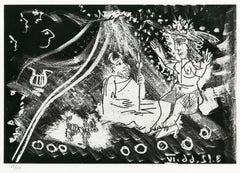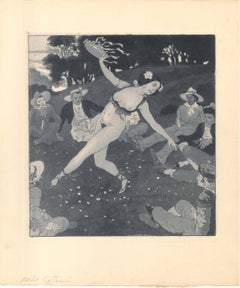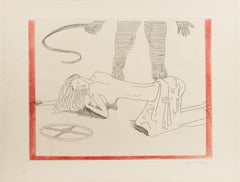Man Ray Nude Prints
Born Emmanuel Radnitzky, Man Ray was a famous American filmmaker, painter and photographer. His career is distinctive, above all, for the success he achieved in both the United States and Europe. First maturing at the center of American modernism in the 1910s, he made Paris his home in the 1920s and 1930s. In the 1940s, he crossed the Atlantic once again and spent periods in New York and Hollywood.
Ray’s art spanned painting, sculpture, film, prints and poetry, and in his long career, he worked in styles influenced by Cubism, Futurism, Dada and Surrealism. He also successfully navigated the worlds of commercial and fine art and came to be a sought-after fashion photographer. Ray is perhaps most remembered for his photographs of the inter-war years, in particular, the camera-less pictures he called "Rayographs," but he always regarded himself first and foremost as a painter. Although he matured as an abstract painter, Ray eventually disregarded the traditional superiority painting held over photography and happily moved between different forms. Dada and Surrealism were important in encouraging this attitude; they also persuaded him that the idea that motivates a work of art was more important than the work of art itself.
André Breton once described Ray as a pre-Surrealist, something which accurately describes his natural affinity for the style. Even before the movement had coalesced, in the mid-1920s, his work, influenced by Marcel Duchamp, had Surrealist undertones. He would continue to draw on the movement's ideas throughout his life. Ray's work has ultimately been very important in popularizing Surrealism.
Find original Man Ray art on 1stDibs.
1970s Modern Man Ray Nude Prints
Etching, Aquatint
1960s French School Man Ray Nude Prints
Aquatint
Early 1900s Modern Man Ray Nude Prints
Etching, Aquatint
1960s French School Man Ray Nude Prints
Aquatint
20th Century Surrealist Man Ray Nude Prints
Watercolor, Etching, Aquatint
1970s Surrealist Man Ray Nude Prints
Etching, Aquatint, Intaglio
Mid-20th Century Modern Man Ray Nude Prints
Aquatint
1970s American Modern Man Ray Nude Prints
Aquatint, Etching
1970s Surrealist Man Ray Nude Prints
Etching, Aquatint, Color
1990s Modern Man Ray Nude Prints
Etching, Aquatint
20th Century Surrealist Man Ray Nude Prints
Watercolor, Etching, Aquatint
1990s Man Ray Nude Prints
Etching, Aquatint
1920s Expressionist Man Ray Nude Prints
Drypoint, Etching, Aquatint
1970s Surrealist Man Ray Nude Prints
Color, Etching, Aquatint
1960s Surrealist Man Ray Nude Prints
Etching, Aquatint
1960s Surrealist Man Ray Nude Prints
Aquatint, Etching
1970s Modern Man Ray Nude Prints
Etching, Aquatint
1960s Dada Man Ray Nude Prints
Aquatint, Etching
1960s Dada Man Ray Nude Prints
Aquatint, Etching
Man Ray nude prints for sale on 1stDibs.
Artists Similar to Man Ray
- What did Man Ray create?1 Answer1stDibs ExpertApril 5, 2022Man Ray created paintings, collages and films, but he is best known for photography. While working in his darkroom, he discovered that by moving objects around on photosensitive paper he could create unique images dubbed rayographs or photograms. Find a collection of Man Ray art on 1stDibs.
- 1stDibs ExpertApril 5, 2022Man Ray, an American photographer, painter and filmmaker, was known for his revolutionary experimentation with photography, including making “cameraless” pictures by placing objects on light-sensitive paper and exposing the paper to light. Ray called these photographs “rayographs.” On 1stDibs, Shop a collection of authentic Man Ray photographs from top sellers worldwide.
- 1stDibs ExpertOctober 15, 2024Man Ray, the Surrealist photographer, was born Emmanuel Radnitzky. His career is distinctive for the success he achieved in both the United States and Europe. Ray’s art spanned painting, sculpture, film, prints and poetry, and in his long career, he worked in styles influenced by Cubism, Futurism, Dada and Surrealism. He also successfully navigated the worlds of commercial and fine art and became a sought-after fashion photographer. Ray is perhaps most remembered for his photographs of the interwar years, in particular the camera-less pictures he called "Rayographs." Shop a variety of Man Ray art on 1stDibs.
- Why did Man Ray change his name?1 Answer1stDibs ExpertApril 26, 2024Man Ray changed his name in response to antisemitic attitudes that were impacting his work during the early 20th century. "Man" came from his nickname, Manny, shortened from Emmanuel. For his surname, Ray took the first two and final letters of his birth name, Radnitzky. Explore a range of Man Ray art on 1stDibs.


